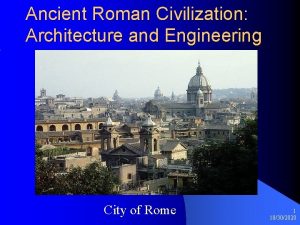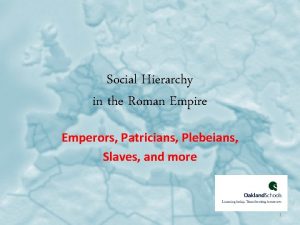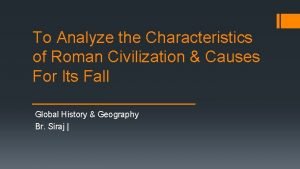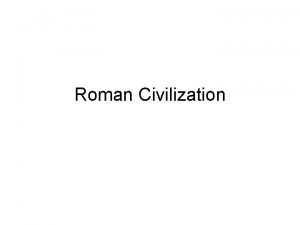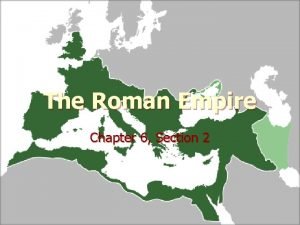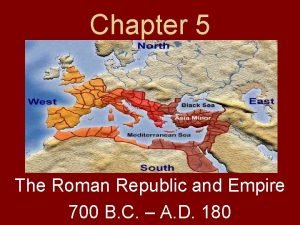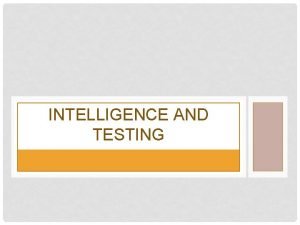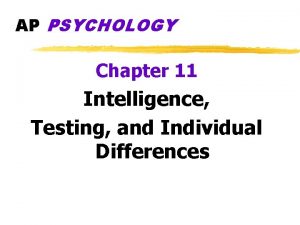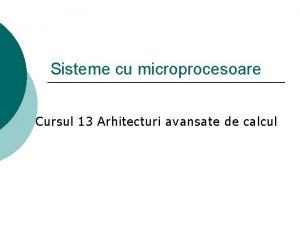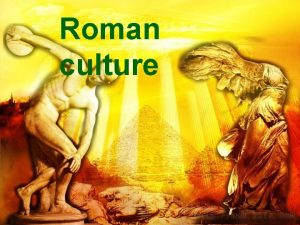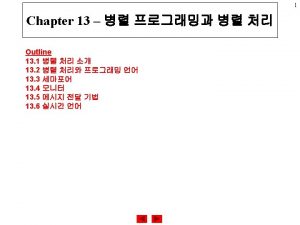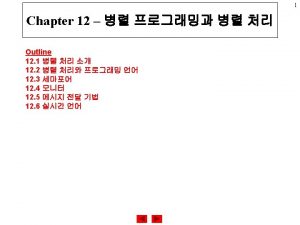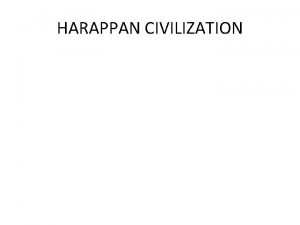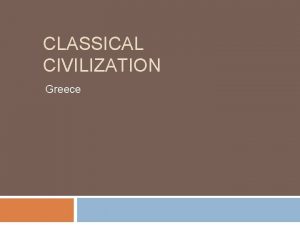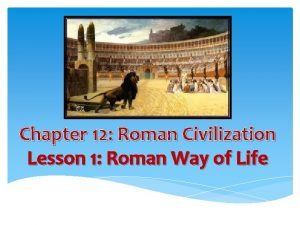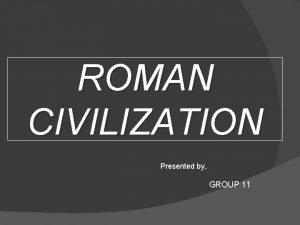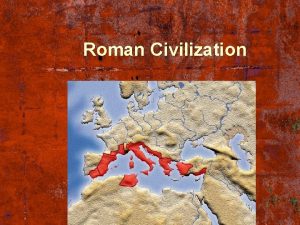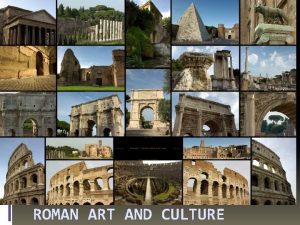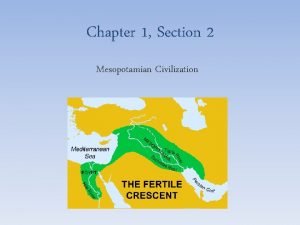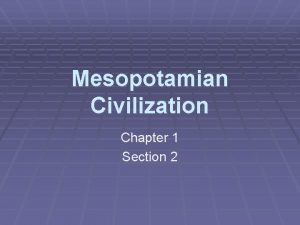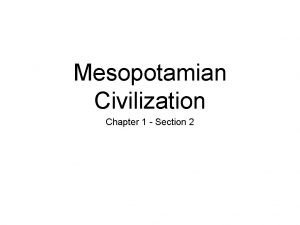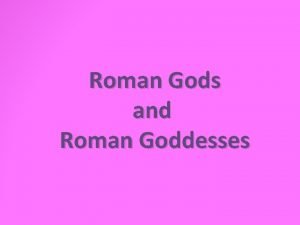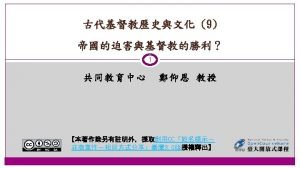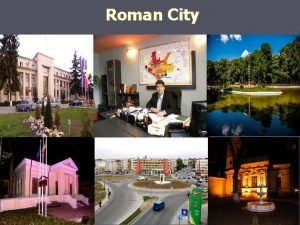Chapter 9 Roman Civilization Mr Flynn Section 1























- Slides: 23

Chapter 9: Roman Civilization Mr. Flynn

Section 1: Life in Ancient Rome Roman Culture • The Romans admired and studied Greek statues, buildings, and ideas • They copied the Greeks in many ways, but changed what they borrowed to suit their own needs • Romans admired Greek art and architecture • Greek statues were perfect, but Roman statues were more realistic and included the imperfections • They also used much of Greek architecture, but added arches and domes • They were also the first to use concrete in their buildings. Concrete made buildings sturdier and allowed them to build taller

Roman Literature • Roman writers based most of their writing on the writing of Greek authors • Virgil drew some of his ideas from Homer’s Odyssey, the Aenid describes Aeneas’ travels and the “story of Rome” • The poet Horace wrote satires-these works poked fun at human weakness, he also composed odes- or poems that express strong emotions about life • Like the Greeks, the Romans had historians that recorded the events of their civilization- Livy- wrote his “History of Rome” in 10 BC, Livy greatly admired early Romans and he believed people should know their history • The most lasting of the things from Roman culture may be their language, Latin, which shaped the languages of many civilizations, including our English words today

Daily Life in Rome • By the time of Augustus, a million people lived in Rome and the city was planned out carefully into roads that crossed at right angles • At the center of Rome was the Forum, this served as a marketplace and public square • Wealthy Romans lived in large, comfy houses • The city of Rome was crowded, noisy, and dirty. Most people were poor and lived in apartments made of stone and wood • To keep the people happy, the Roman government would have “bread and circuses” or free grain and entertainment • The biggest attractions were chariot races and gladiator contests. Gladiators fought animals or each other and were admired like our sports heroes today

Roman Science and Engineering • The Romans also learned from Greek science. • A Greek doctor named Galen brought many medical ideas to Rome; including anatomy, the study of body structure • Another important scientist of the Roman Empire was Ptolemy. He studied the sky and mapped over 1000 different stars • Roman engineers built an impressive system of roads and bridges to connect the empire • They also used advanced engineering to supply their cities with freshwater. Engineers built aqueducts, or long troughs supported by arches that brought water from the hills to the cities

What was family life like? • Family life was important to the Romans, their families were large, they included not only parents and children, but also married children and their families, other relatives, and enslaved servants • The father was the head of the household. He was called paterfamilias or “father of the family”- had complete control over family members • Wealthy families hired tutors to teach their younger children at home, some older boys did go to schools where they learned reading, writing, and rhetoric, or public speaking. • Girls did not go to school, they learned reading and writing at home, they also learned household duties • Between ages 14 and 16 , a Roman boy celebrated becoming a man. He would burn his toys as offerings to the household gods. • He would put on a toga, join his family business, became a soldier or begin a career in government

Women in Rome • Roman women did not become adults until they were married • Women in early Rome had some rights, but they were not full citizens • The freedoms that a woman enjoyed depended on her husband’s wealth and standing • Wealthy women had a great deal of independence. They could own land, run businesses, and sell property. • Women with less money, had less freedom. They spent most of their time working in their houses or helping their husbands in family-run shops

How did Romans Treat Enslaved People? • Slavery was a part of Roman life from early times • Thousands of prisoners from conquered lands were brought to Italy. Most spent their lives performing slave labor. By 100 BC, about 40 percent of the people in Italy were enslaved. • For most enslaved people life was miserable. They were punished severely for poor work or for running away. To escape their hardships, enslaved people often rebelled • The most famous slave revolt was led by a gladiator named Spartacus. • Under Spartacus a force of 70, 000 enslaved people defeated several Roman armies. • The revolt was crushed two years later. Spartacus and 6, 000 of his followers were crucified, or put to death by nailing on a cross.

Section 2 - The Fall of Rome • In AD 180 Marcus Aurelius died. His son Commodus took over • Commodus was cruel and wasted money. Instead of ruling Rome, Commodus spent much of his time fighting as a gladiator • In AD 192, his bodyguard killed him, this set off a century of fighting and confusion • After Commodus, emperors called Severans ruled Rome. Much of their time was spent putting down revolts and protecting Rome’s borders

Political and Social Problems • When the last Severan ruler died in AD 235, Rome’s government became very weak • For almost 50 years after, army leaders fought each other for the throne. During the time, Rome had 22 different emperors • Fewer Romans honored the old ideals of duty, courage, and honesty • Many government officials took bribes • Many wealthy citizens even stopped paying taxes • Fewer people went to schools and a large number of the empire’s people were enslaved. • Wealthy Romans supported slavery- cheap work

Economic and Military Problems • During the AD 200 s, Rome’s economy began to fall apart • Government weakened-law and order broke down • Soldiers and invaders seized crops, farmers grew less food, hunger spread • Less goods are made, less jobs • A plague, or a disease that spreads widely also did much damagekilled 1 in 10 people • Inflation-or rapidly increasing prices, was the next problem • Prices went up, and many people began using no money at all • They began to barter, or exchange goods without using money • Invaders swept in and Rome could not pay an army, so they brought in soldiers who were not loyal to Rome

What were Diocletian’s Reforms? • In AD 284, a general named Diocletian became emperor • To stop the decline, he installed reforms, or political changes to make things better • Empire was too big for one person to rule, divided it into 4 parts, named officials to rule these parts, but had authority • To slow inflation, set the price of goods and wages • To make sure there were enough products, he ordered workers to stay at the same job until they died • People ignored the rules and Diocletian did not have enough power to make them obey

Who was Constantine? • In AD 305, Diocletian retired from office and after a period of fighting, Constantine became emperor in AD 312 • To aid the economy Constantine issued several orders • Sons of workers had to follow their fathers’ trades, sons of farmers had to work same land as their fathers, sons of soldiers had to serve in the army • Constantine could not halt the decline in the west, named new capital in the east, Constantinople • Today: called Istanbul, Turkey

Rome Falls • Both Diocletian and Constantine failed to save the Roman Empire • When Constantine died in AD 337, fighting broke out again • In AD 395, the Roman Empire split into two separate empires. Western Roman Empire. Rome and the Eastern Roman Empire. Constantinople

Rome Falls Cont. • As Rome declined, it was no longer able to hold back the Germanic tribes on its borders • In AD 410, Visigoth leader Alaric and his soldiers captured Rome itself. • It was the first time Rome had been conquered in 800 years, the people were shocked • Another Germanic tribe known as the Vandals overran Spain and Northern Africa • A Germanic general named Odoacer took control overthrowing the 14 year old emperor, Romulus Augustulus, the last Roman emperor, marking the end of the Roman empire

The Legacy of Rome • Roman ideas of law are still with us today as written in the Twelve Tables • People are equal under law, we expect judges to decide cases fairly, and consider people innocent until proven guilty • The alphabet of the Latin language has shaped the world and many languages (English, Italian, Spanish) just to name a few

Section 3 - The Byzantine Empire • Although the Western Roman Empire fell to Germanic invaders, the Eastern Roman Empire prospered becoming known as the Byzantine Empire • The Byzantine Empire reached its peak around the AD 500 s stretching west to Italy, south to Egypt, and east to the border with Arabia • Greeks made up the empire’s largest group, but Egyptians, Syrians, Arabs, Armenians, Jews Persians, Slavs, and Turks could be found in the empire

Why is Constantinople important? • Constantine moved the Roman capital to Constantinople, during the Byzantine Empire, it was thriving and had become one of the world’s great cities • One reason: location, it was located on the waterways between the Black Sea and the Aegean Sea • Harbors offered safe shelter for fishing boats, trading ships, and warships • It was also at the crossroads of trade routes between Europe and Asia • Laying on a peninsula, it was protected by the Seas on three sides, on the fourth side a huge wall

Greek Influence • The Byzantines first followed Roman ways, in fact Constantinople was known as the “New Rome” • The city even had an arena for chariot races and events called the Hippodrome • Political and social life was also based on Roman, emperors spoke Latin, and enforced Roman laws • As time passed, the Byzantine Empire became less Roman and more Greek • Most Byzantines spoke Greek and honored their Greek past • Emperors and officials began to speak Greek as well • The culture was influenced by Egyptians, Slavs, and Persians • The cultures blended together and from AD 500 -AD 1200, the Byzantines had one of the world’s richest and most advanced empires

Emperor Justinian • Justinian became the emperor of the Byzantine Empire in AD 527 and ruled until AD 565 • Justinian was a strong leader who controlled the military, made laws, and was supreme judge. His order could not be questioned • Justinian’s wife Theodora helped him run the empire. She was a former actress who was strong willed and helped make decisions. • She convinced Justinian to give women more rights, Byzantine women for the first time could own land • In AD 532 she helped save throne. Angry taxpayers attacked but Theodora advised that Justinian stand his ground, he did and crushed the uprising

Justinian’s Conquests • Justinian wanted to reunite the Roman Empire and bring back Rome’s glory • To do this he had to conquer Western Europe and northern Africa, so he hired a general named Belisarius to strengthen and lead the Byzantine army • During Justinian’s reign, the Byzantine military conquered most of Italy and northern Africa and defeated the Persians in the east. • After he died, the empire did not have enough money to hold the territory in the west.

Justinian’s Law Code • Justinian decided that the empire’s laws were disorganized and too difficult to understand • He put together a group to analyze and reform the law code • The group’s new simplified code became known as the Justinian Code. • Officials, businesspeople, and individuals could now more easily understand the law. • Over the years, the Justinian Code has had a great influence on the laws of almost every country in Europe.

Byzantine Civilization • The Byzantine Empire lasted approximately 1, 000 years • The city of Constantinople was one of the great cities of the world during its time due to the trade because of its location • Art was supported by the emperors. Most art was about religious figures. • Mosaics- or pictures made from many bits of colored glass or stone were very common. • Women’s roles were expanded by Theodora, but they were encouraged to do the house work and take care of the family. They could be regents though. • A regent is a person who stands in for a ruler who is too young or too ill to govern.
 Roman architecture and engineering
Roman architecture and engineering Social hierarchy of ancient rome
Social hierarchy of ancient rome Characteristics of roman civilization
Characteristics of roman civilization Roman contributions to western civilization
Roman contributions to western civilization Roman civilization clothing
Roman civilization clothing The roman empire chapter 6 section 2
The roman empire chapter 6 section 2 The roman republic chapter 6 section 1
The roman republic chapter 6 section 1 Politheistic
Politheistic Roman republic vs roman empire
Roman republic vs roman empire Flynns taxonomy
Flynns taxonomy Deirdre flynn
Deirdre flynn Dane flynn
Dane flynn Average iq by age
Average iq by age Sisd architecture
Sisd architecture Flynn's classification
Flynn's classification Classificação de flynn
Classificação de flynn The abyss behind the scenes
The abyss behind the scenes O'flynn uniforms
O'flynn uniforms Sap flynn portal
Sap flynn portal Gloria chavez and ronald flynn
Gloria chavez and ronald flynn Ap psychology unit 11 practice test
Ap psychology unit 11 practice test Flynn creek crater
Flynn creek crater Taxonomia de flynn
Taxonomia de flynn Flynn
Flynn
